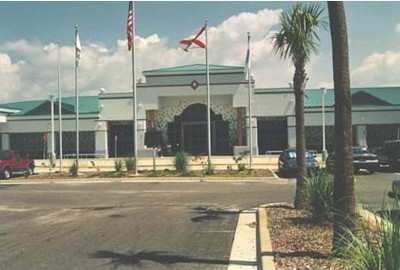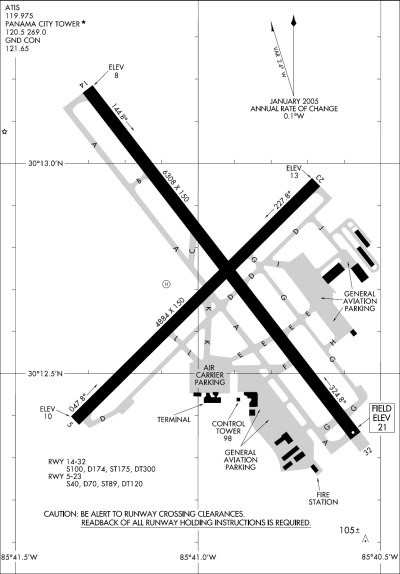Challenge Period Has Expired
The Panama City–Bay County Airport and Industrial District
(Airport Authority) announced this week it had received the final
State of Florida permits necessary to move forward with the
relocation of the Panama City-Bay County International Airport
(KPFN). Issuance of the state permit clears the way for the US Army
Corps of Engineers to issue a Section 404 permit, the final permit
necessary before construction of the new airport can begin.

All challenge periods for the State of Florida permits have
expired, and the issuance of these permits concludes the state
permitting process.
The state permits were issued as part of an Ecosystem Management
Agreement (EMA) between the Airport Authority and the Florida
Department of Environmental Protection. The EMA includes a
comprehensive mitigation plan for environmental impacts of the
relocation and construction of the Panama City-Bay County
International Airport.
The EMA was reached using Florida’s innovative Ecosystem
Team Permitting (ETP) approach, a process whereby environmental
impacts associated with the airport relocation were avoided or
minimized, and a comprehensive mitigation plan was developed
through consensus building between the Airport Authority,
regulators, and other stakeholders, including local environmental
organizations.

According to the Florida Department of Environmental Protection,
the ETP process resulted in a number of net ecosystem benefits as a
result of the airport relocation, including:
- The conservation and permanent protection of significant
contiguous portions of the West Bay region, including bay
shoreline, wetlands, streams, uplands and the overall
watershed;
- A wetlands function lift significantly in excess of that needed
to compensate for functional losses (impacts);
- A mitigation plan that significantly exceeds both state and
federal requirements for all possible current and future impacts,
and
- An effort to restore a large contiguous tract of uplands and
wetlands to approximate historical conditions more suitable for
dependent species native to the area.
"Receiving the state permits represents another major milestone
in the effort to relocate our airport," said Airport Authority
chairman Joseph Tannehill. "We are one step closer to making our
new airport a reality and one step closer to realizing this
community’s vision for an airport that meets all federal
safety and design standards while providing us a platform to
compete for better, more competitive air service."
The Airport Authority has been working for more than 10 years to
address deficiencies at the current airport site. In 1998, the
Airport Authority abandoned an effort to extend the existing runway
system into Goose Bayou because of strong local environmental
opposition. One year later, the Airport Authority began focusing on
relocation as an option after the St. Joe Company, the
county’s largest private landowner, agreed to work with the
Airport Authority to identify a suitable site for relocation.
In May 2006, after more than five years of study, the Federal
Aviation Administration (FAA) issued its Final Environmental Impact
Statement selecting relocation to the West Bay site as its
Preferred Alternative for addressing the deficiencies at the
current airport site. In September 2006 the FAA issued its Record
of Decision approving relocation to West Bay.
"There are obvious aviation-related benefits in relocating the
airport to West Bay," said Tannehill. "But there are environmental
and economic development benefits too. Relocation of the airport is
the catalyst for the creation of the West Bay Preservation Area.
Ultimately, tens of thousands of acres that will be permanently
protected, including miles of West Bay shoreline."

"We are very proud that the mitigation plan for the airport goes
above and beyond what is required by law," Tannehill added. "We
have worked closely with dozens of local environmentalists to
ensure that significant long-term environmental benefits will
result from this relocation."
"We continue to make tremendous progress. If all goes according
to plan, we should be in a position to break ground on the airport
next year."
 ANN's Daily Aero-Term (05.07.25): Terminal Radar Service Area
ANN's Daily Aero-Term (05.07.25): Terminal Radar Service Area ANN's Daily Aero-Linx (05.07.25)
ANN's Daily Aero-Linx (05.07.25) Classic Aero-TV: Anousheh Ansari -- The Woman Behind The Prize
Classic Aero-TV: Anousheh Ansari -- The Woman Behind The Prize NTSB Prelim: Bell 206B
NTSB Prelim: Bell 206B Airborne-NextGen 05.06.25: AF Uncrewed Fighters, Drones v Planes, Joby Crew Test
Airborne-NextGen 05.06.25: AF Uncrewed Fighters, Drones v Planes, Joby Crew Test





